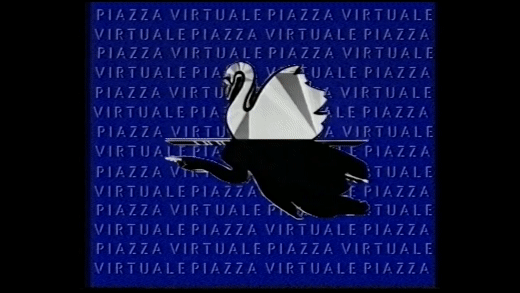Piazza virtuale
“Piazza virtuale” was a media experiment that took place at documenta IX in 1992. Van Gogh TV, a group of artists and hackers, wanted to transfer the concept of an Italian piazza – a place for casual meetings and conversations – into the media. To do this, they used all the electronic media available at the time to involve the television audience, who could watch the program daily on 3Sat, in what was happening on the screen.
Via telephone, fax, mailbox and videophone, people could participate in the program, join discussions, get to know each other, make music and paint together or move an interactive camera in the studio in Kassel. Via videophone, programs from the so-called “Piazzettas” – micro studios in many cities in Germany, in other European cities and even in Japan – were broadcast to Kassel.
In this early “virtual community” (Howard Rheingold), many phenomena that are today seen as defining characteristics of net culture could be observed for the first time by a wider public in the German-speaking world. As a media art project shaped by audience’ contributions, the project anticipated many of the characteristics of contemporary social media. For “Piazza virtuale,” Van Gogh TV was awarded the Siemens Media Art Prize at the Center for Art and Media Technology (ZKM) in 1993 and an “Honorary Mention” at the Prix Ars Electronica.
Van Gogh TV, the organizers of “Piazza virtuale,” had a number of previous art projects and partner organizations. Its members came from an art scene in which artistic work in collectives was as common and important as presenting these activities under names reminiscent of brand or company names. Van Gogh TV was founded in 1986 by artists Mike Hentz, Karel Dudesek, Benjamin Heidersberger and Salvatore Vanasco. Hentz and Dudesek had previously belonged to the artist group Minus Delta t, founded in 1978, which carried out actions, performances and concerts against the backdrop of the German punk and new wave scene. Minus Delta t also carried out a series of projects that, in addition to their performances and concerts, already worked with media such as video, radio, computers and computer networks, slow scan video, and television. These included “The Project” at ars electronica in 1986 and their participation in documenta 8 in 1987, where, in addition to their appearance as “cultural police” and performances at the Manhattan discotheque, the group parked a media bus with a video editing station and other production media on Friedrichsplatz in front of the Fridericianum, from which they operated a pirate radio station during the exhibition.

In 1987 Ponton was founded, which in the same year set up its own Media Lab in Hamburg and was supported by the Hamburg cultural administration through project funding. Before “Piazza virtuale”, the group carried out the projects “Re-Publik-TV” (1989) and “Hotel Pompino” (1990) at ars electronica as well as “Ballroom TV” (1991) at the Berlin club 90 Grad, which was also broadcast on the Berlin private station Fernsehen aus Berlin (FAB). As with the Bangkok project of Minus Delta t, video recordings were made during their travels through Eastern Euope in 1989, which were collected and exhibited under the name “Archive Europa”.
The group founded the Junge Gesellschaft zur Förderung der Kunst und Medientechnologie e. V. Hamburg as an institutional platform, and Salvatore Vanasco, Karel Dudesek and Mike Hentz held seminars, conferences and education events for students and young media creators under the name Universcity TV. After “Piazza virtuale”, in 1993 there was a remake of the project broadcast by the Japanese TV channel NHK. In 1994, Van Gogh TV showed “Service Area a.i.” at ars electronia.